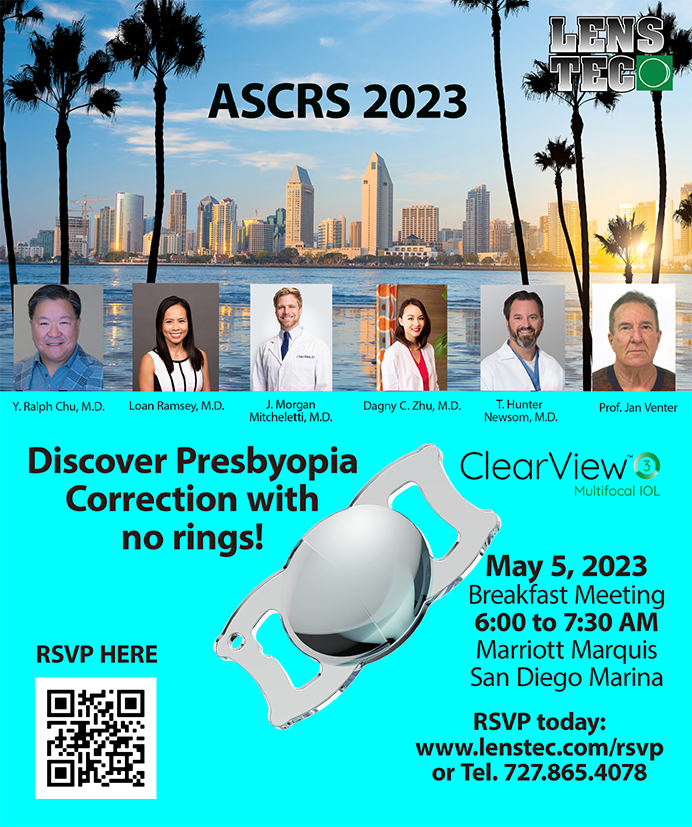
The most important thing to consider with regard to premium IOL explantation is to avoid it if possible. That calls for good patient selection, careful screening of candidacy for lenses, and the setting of appropriate patient expectations. Despite these cautions, however, there will be cases in which explantation and exchange become necessary.
The most common complaint I hear from premium IOL patients relates to dysphotopsias, such as glare, halos, and starbursts, that are caused by the diffractive optics of multifocal IOLs. Before cataract surgery, it is important not to say to patients, “you may experience” or “some people experience,” but rather: “You will experience these effects, but most people learn to ignore them and tune them out. However, some people won’t be able to, and there may be a need to exchange the lens.”
I also emphasize that, although exchanging the lens will fix some or hopefully all of these issues, as a result the patient will lose the positive effects gained from the multifocal IOL. That is, he or she will lose reading or intermediate vision, depending on the IOL. Many patients, when faced with that choice, will choose to keep the lens and learn to look past these effects.
BEFORE EXPLANTATION
As noted at the outset, despite careful patient selection, appropriate expectations management, and successful surgery, some patients will still have difficulties. Before you exchange the lens, you should do your best to make the lens work for that patient.
The ocular surface must be optimized for a patient to be happy with his or her multifocal IOL. Patients with these lenses are much more sensitive to disturbances such as dry eye and resulting irregular astigmatism than patients with other types of IOLs. Because dry eye can worsen after any successfully performed cataract surgery, it is important to be proactive with treatment. Ideally, this is a conversation that should begin before surgery, not after, emphasizing that dry eye is a chronic disease. This avoids the perception of dry eye as a complication.
Residual refractive error can have a huge impact on patient satisfaction with multifocal lenses, so the patient must be as close to a plano sphere refraction as possible postoperatively. As little as 0.50 D of residual astigmatism can have a huge impact on the prevalence of and disturbance caused by unwanted side effects such as glare and halos. For any patient who has a residual refractive error, I correct it in a demonstration fashion first, preferably via a contact lens trial so they can experience the correction in the real world; glasses are an option for the contact lens–intolerant patient. If that solves his or her problem, I proceed with laser vision correction. I never promise patients that correcting residual refractive error will fix glare and halos, but instead let them experience it for themselves.
I also look at the lens itself. You want to make sure the lens is well centered on the patient’s visual axis. A decentered lens can produce substantial glare and halo effects and degrade visual quality. If the lens is not appropriately centered, you should give serious consideration to a recentration procedure before giving up on that lens. Often, lens centration is dependent upon the orientation of the lens haptic-optic junctions, so you likely need to rotate the lens to a different orientation to achieve improved centration.
You should also make sure that there is no other pathology in the eye. For example, I always look at an OCT image of the macula before cataract surgery and again during the postoperative period, especially if a patient has some concern about his or her vision. Cystoid macular edema can be too subtle to diagnose at the slit lamp, but it is obvious on OCT, and it can have a huge impact on patient satisfaction.
PREPARING FOR THE EXCHANGE
If the patient remains dissatisfied after you explore these other alternatives, it is likely time for an IOL exchange. Keep in mind that this is a premium patient who expects a premium outcome, even if you are exchanging for a monofocal lens. If he or she has a toric multifocal IOL, you should be prepared to replace it with a toric monofocal lens. Be sure to mark the current axis of the toric lens and, if appropriate, the desired axis for the new lens.
If you are exchanging for a nontoric monofocal lens, you still need to aim for the desired refractive result. If there was some residual refractive error, you must change the IOL power to account for it.
The questions of the desired new lens power and where the axis of a toric lens should be positioned can be easily calculated using the Barrett Rx Formula Outcome Analysis website (http://calc.apacrs.org/barrett_rx105/), which takes into account not only the existing lens and its current refractive state, but also the change in keratometry that may have occurred as a result of the surgical incisions and the potential change in the A constant from changing the IOL.
When I do an exchange, I go into the OR with a printout of the analysis that shows me exactly what lens I plan to implant and where it should be oriented. I also have backup plans; although our goal is an in-the-bag IOL exchange, there can be challenges that lead to the need for a sulcus-fixated lens.
In counseling the patient, recognize what he or she is going to gain and what he or she is going to lose. I put it in those stark terms. I say: “We are going to do our best to get rid of what has been bothering you, but you have to recognize that the parts of this lens that produce the glare are the same parts that give you your reading vision.” This helps people understand that what is causing them trouble is also giving them benefits. I also warn them that some people experience glare and halos with any artificial lens, and that there is no guarantee this will solve all their problems.
THE PROCEDURE
If the primary surgery was relatively recent, I prefer to reuse the original temporal incision by making a sharp dissection at the edge of the incision and then blunt dissection to reenter the anterior chamber. By doing this, I avoid creating new incisions that could change the patient’s corneal astigmatism and potentially throw off the planned final outcome. Having reopened the incision, I typically expand it slightly to reduce corneal stretch when the IOL is removed. This is done with a keratome in a controlled fashion after OVD is placed in the eye.
The next step is to free any adhesions from the anterior capsule to the IOL. My preferred technique is to use a 30-gauge 0.5-inch needle bent bevel-down to a 45° angle and placed on the cannula of a cohesive OVD. I do enough dissection to get the full bevel beneath the capsule and then inject a bubble of OVD to tent up the capsule.
I then reverse the orientation of the needle so that it is bevel-up and move the tip along a few clock hours of the anterior capsule edge, injecting OVD as I move to tent up that part of the capsule. I then exchange the needle for a long, blunt cannula and viscodissect the bag around 360°.
I operate from a temporal approach with a paracentesis on the left-hand side, which provides access to one of the haptic-optic junctions. Many times the other haptic-optic junction is nearly subincisional. Fashioning a nasal paracentesis on the opposite side of the cornea allows me to dissect that aspect of the capsule as well.
With certain IOLs, there are areas that fibrose more tightly to the bag, such as a terminal haptic bulb. Careful dissection is necessary to avoid tearing the bag or causing zonular dehiscence when removing the IOL. If visualization is poor, iris hooks can be helpful. After I have viscodissected the anterior capsule from the IOL, I do the same thing for the posterior side.
Once the bag is fully dissected from the lens, I use a Sinskey hook to slowly but steadily rotate the IOL, making sure I am not creating undue stress on the zonules, especially along the haptics. This may reveal areas that need further dissection in order to be free of adhesions. I find it helpful to run the Sinskey hook along the outer edge of the haptic, pulling inward gently. Once the IOL is free, I elevate it in its entirety into the anterior chamber and place OVD behind the lens to push the capsule posteriorly.
There are multiple ways to remove the lens implant. For an acrylic IOL, strong IOL-grasping forceps can be used to grasp at one haptic-optic junction, and then the IOL can be removed in its entirety through an incision of approximately 2.8 mm without sectioning the lens or otherwise cutting it; this is my preferred technique in most cases. Alternatively, the IOL can be sectioned into two or three pieces using micrograspers and scissors. In patients who have floppy irides or preexisting endothelial compromise such as Fuchs dystrophy, I use this approach.
After the IOL is removed, there is one last nuance for implanting a new lens, which is to make sure the capsular bag is fully expanded, not just in the areas where you dissected the previous lens. Otherwise, you will have a challenge in getting the new lens to rotate into its desired position.
POSTOPERATIVE CARE
I follow the same postoperative regimen that I would after a primary cataract surgery. I use a combination antibiotic, steroid, nonsteroidal drop (Pred-Gati-Brom, ImprimisRx) four times per day for 1 week and then taper in weekly increments. I find that patients respond just as well to this regimen as they did following the original cataract surgery.
It is important to note that most patients who get to the point of needing an IOL exchange are challenging to please in the first place. You can achieve optimal outcomes and a 20/20 result, but you may still find that some of the problem originated with the patient’s expectations. This is why it is important that, prior to the IOL exchange, you should not tell the patient that this procedure will completely resolve all glare and halos. If you set the expectation that the patient is going to be completely glare-free, you set yourself up for a frustrated patient.




